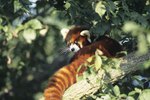
At less than 5 pounds and around 2 feet in length from nose to tail, the fennec fox is the smallest fox in the world. They can be found at zoos, and even in a few homes as pets, all over the world, but their native habitat is the deserts of North Africa. They have some pretty neat genetic tricks to help them survive the harsh desert environment.
The Night Life
The deserts of North Africa get hot, and a little furball like a fennec fox could easily get overheated running around in the mid-day sun. That's why these adorable guys are nocturnal. They curl up in a nice, cool burrow to sleep the day away, and then go out hunting at night. Their thick fur helps keep them warm during cold, desert nights.
Cool Ears
The most distinguishing feature on a fennec fox is its big, furry ears. They can be as long as 6 inches. That's about a quarter of their total body length. Their huge ears allow them to hear bugs and rodents underground for their dinner. They also provide a lot of extra body surface area to help dissipate body heat and keep the fox cool during those hot, desert days.
Thick, Sandy Fur
Fennec foxes have a thick, sand-colored fur that helps reflect sunlight and keep them cool when they must go out in the daytime. The fur even covers the bottoms of their feet, which prevents the hot sand burning their little toes. The fur on their soles also provides more traction so they can easily run on loose sand and quickly dig their burrows.
Conservative Kidneys
The kidneys of a fennec fox are adapted to retain water and prevent dehydration. There is little to no free water in the desert homes of fennec foxes. While they will drink water when it's available, they can survive long periods on only the moisture from what they eat and, possibly, dew that collects inside their burrows.
References
Photo Credits
-
NA/AbleStock.com/Getty Images




